2003 NISSAN FRONTIER steering
[x] Cancel search: steeringPage 196 of 272

VG33ER engine
1. Fuse/fusible link holder
2. Power steering fluid reservoir
3. Automatic transmission fluid dipstick
(A/T model)
4. Supercharger
5. Brake fluid reservoir
6. Air cleaner
7. Windshield washer fluid reservoir
8. Engine oil dipstick
9. Radiator cap
10. Engine oil filler cap
11. Coolant reservoir
12. Battery
WDI0270
8-8Maintenance and do-it-yourself
ZREVIEW COPY:Ð2003 Truck/Frontier(d22)
Owners Manual(owners)ÐUSA English(nna)
01/15/03Ðarosenma
X
Page 203 of 272
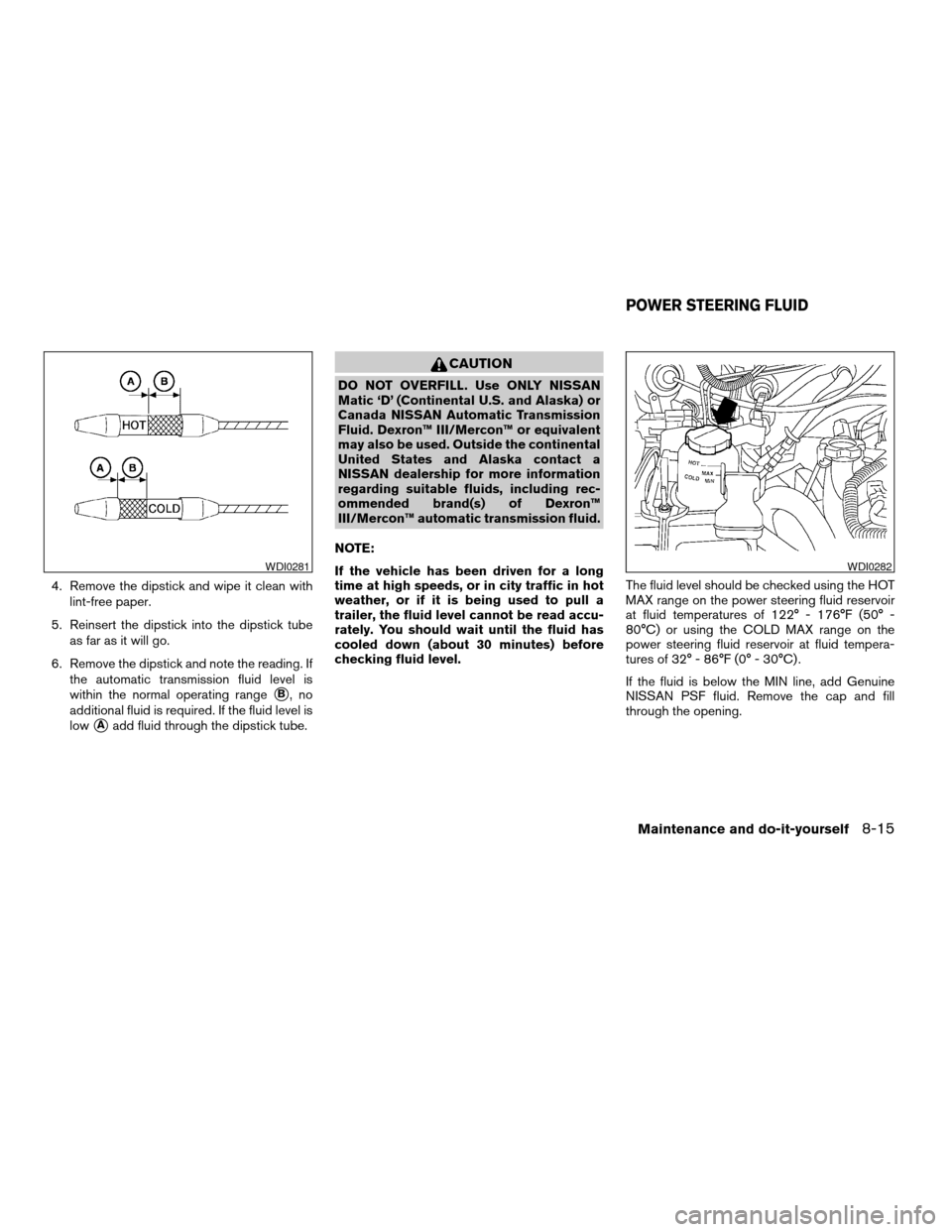
4. Remove the dipstick and wipe it clean with
lint-free paper.
5. Reinsert the dipstick into the dipstick tube
as far as it will go.
6. Remove the dipstick and note the reading. If
the automatic transmission fluid level is
within the normal operating range
sB,no
additional fluid is required. If the fluid level is
low
sAadd fluid through the dipstick tube.
CAUTION
DO NOT OVERFILL. Use ONLY NISSAN
Matic ‘D’ (Continental U.S. and Alaska) or
Canada NISSAN Automatic Transmission
Fluid. Dexron™ III/Mercon™ or equivalent
may also be used. Outside the continental
United States and Alaska contact a
NISSAN dealership for more information
regarding suitable fluids, including rec-
ommended brand(s) of Dexron™
III/Mercon™ automatic transmission fluid.
NOTE:
If the vehicle has been driven for a long
time at high speeds, or in city traffic in hot
weather, or if it is being used to pull a
trailer, the fluid level cannot be read accu-
rately. You should wait until the fluid has
cooled down (about 30 minutes) before
checking fluid level.The fluid level should be checked using the HOT
MAX range on the power steering fluid reservoir
at fluid temperatures of 122° - 176°F (50° -
80°C) or using the COLD MAX range on the
power steering fluid reservoir at fluid tempera-
tures of 32° - 86°F (0° - 30°C) .
If the fluid is below the MIN line, add Genuine
NISSAN PSF fluid. Remove the cap and fill
through the opening.
WDI0281WDI0282
POWER STEERING FLUID
Maintenance and do-it-yourself8-15
ZREVIEW COPY:Ð2003 Truck/Frontier(d22)
Owners Manual(owners)ÐUSA English(nna)
02/25/03Ðbetty
X
Page 208 of 272
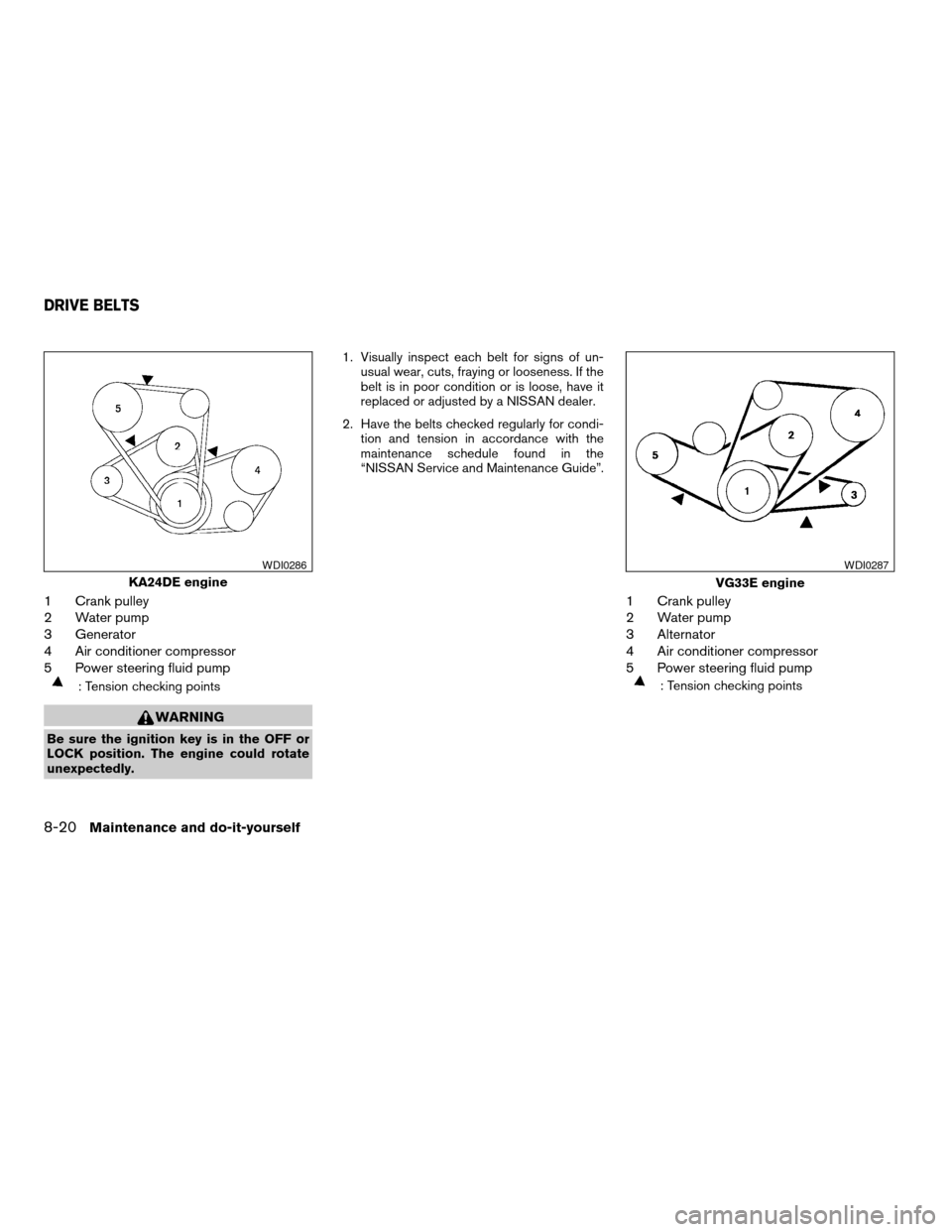
1 Crank pulley
2 Water pump
3 Generator
4 Air conditioner compressor
5 Power steering fluid pump
: Tension checking points
WARNING
Be sure the ignition key is in the OFF or
LOCK position. The engine could rotate
unexpectedly.1. Visually inspect each belt for signs of un-
usual wear, cuts, fraying or looseness. If the
belt is in poor condition or is loose, have it
replaced or adjusted by a NISSAN dealer.
2. Have the belts checked regularly for condi-
tion and tension in accordance with the
maintenance schedule found in the
“NISSAN Service and Maintenance Guide”.
1 Crank pulley
2 Water pump
3 Alternator
4 Air conditioner compressor
5 Power steering fluid pump
: Tension checking points
KA24DE engine
WDI0286
VG33E engine
WDI0287
DRIVE BELTS
8-20Maintenance and do-it-yourself
ZREVIEW COPY:Ð2003 Truck/Frontier(d22)
Owners Manual(owners)ÐUSA English(nna)
01/15/03Ðarosenma
X
Page 209 of 272
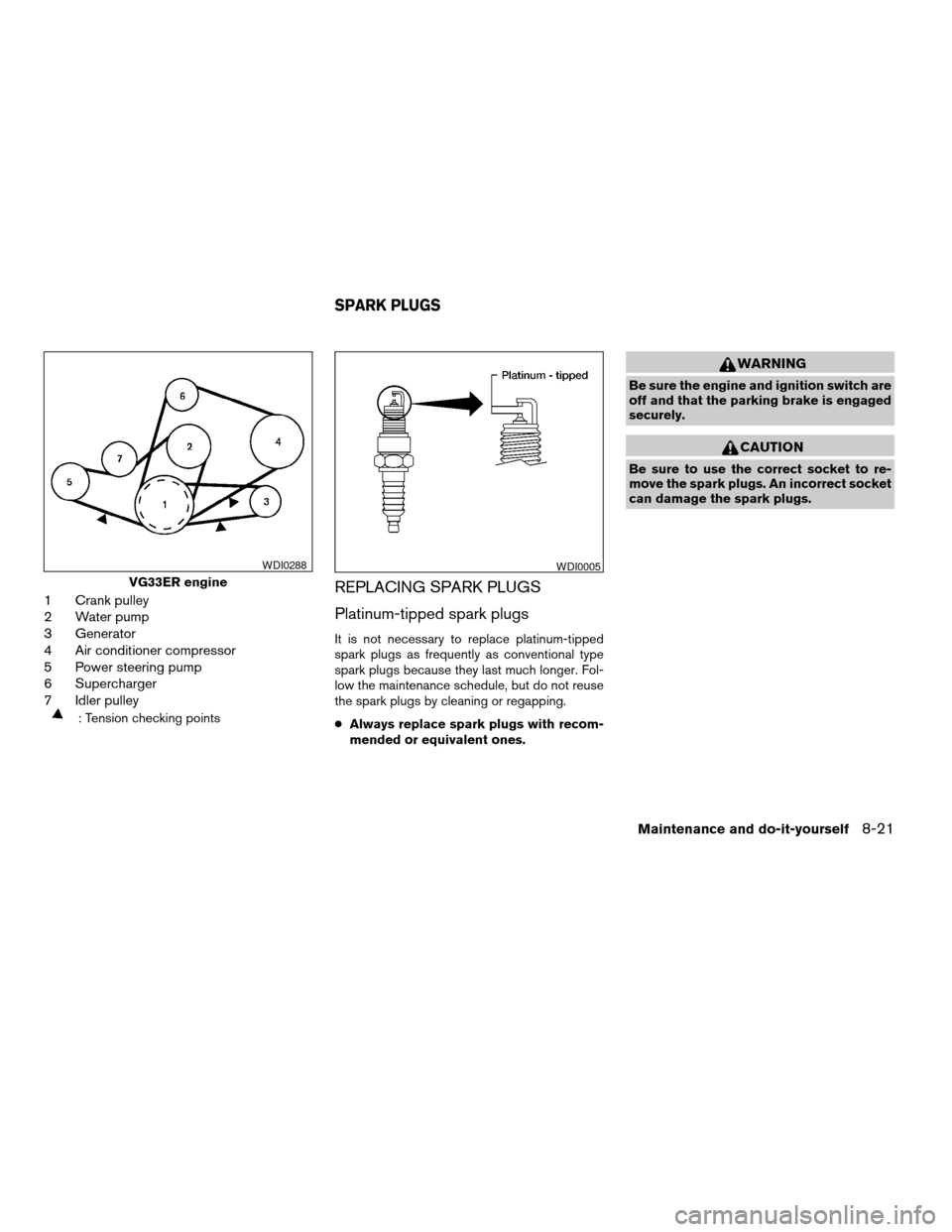
1 Crank pulley
2 Water pump
3 Generator
4 Air conditioner compressor
5 Power steering pump
6 Supercharger
7 Idler pulley
: Tension checking points
REPLACING SPARK PLUGS
Platinum-tipped spark plugs
It is not necessary to replace platinum-tipped
spark plugs as frequently as conventional type
spark plugs because they last much longer. Fol-
low the maintenance schedule, but do not reuse
the spark plugs by cleaning or regapping.
cAlways replace spark plugs with recom-
mended or equivalent ones.
WARNING
Be sure the engine and ignition switch are
off and that the parking brake is engaged
securely.
CAUTION
Be sure to use the correct socket to re-
move the spark plugs. An incorrect socket
can damage the spark plugs.
VG33ER engine
WDI0288WDI0005
SPARK PLUGS
Maintenance and do-it-yourself8-21
ZREVIEW COPY:Ð2003 Truck/Frontier(d22)
Owners Manual(owners)ÐUSA English(nna)
01/15/03Ðarosenma
X
Page 232 of 272
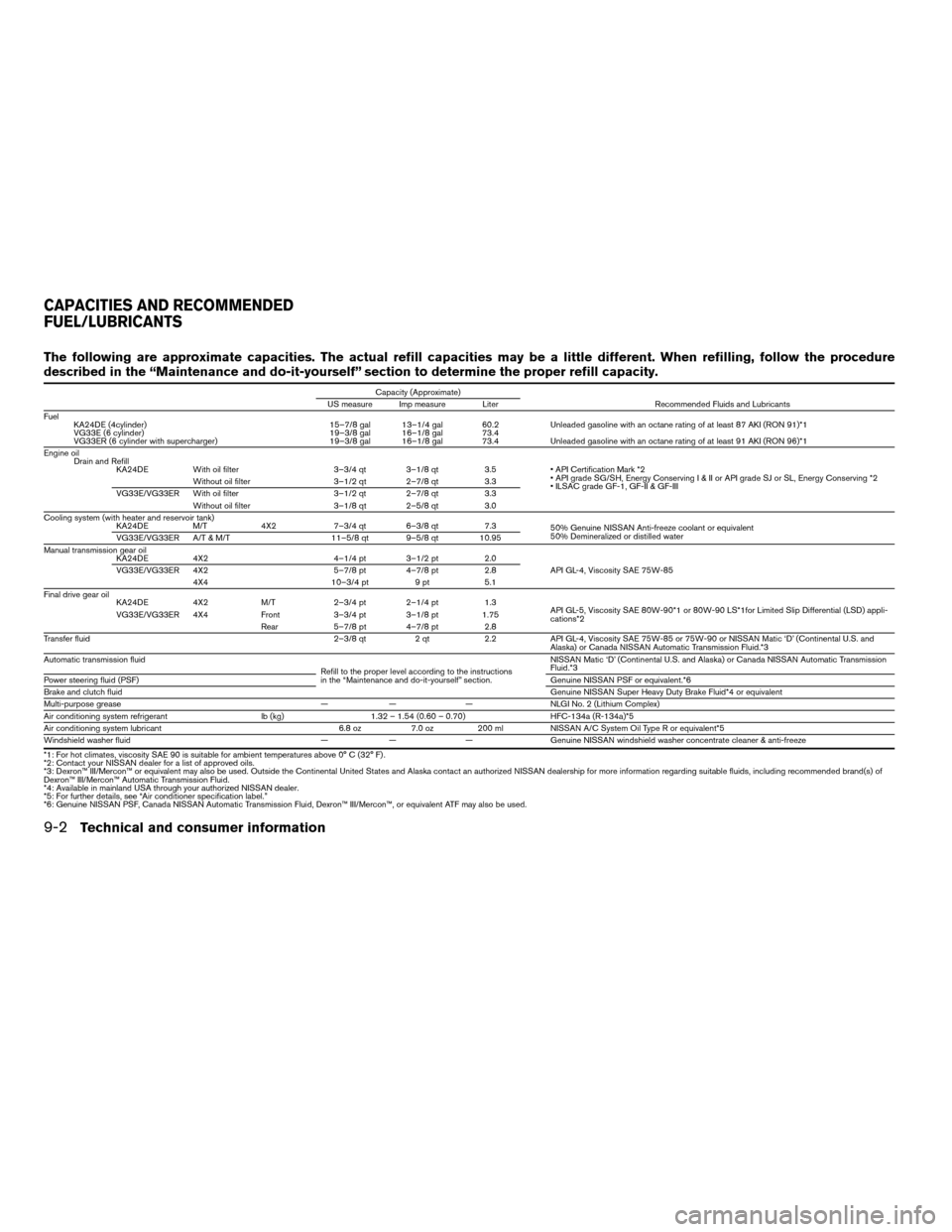
The following are approximate capacities. The actual refill capacities may be a little different. When refilling, follow the procedure
described in the “Maintenance and do-it-yourself” section to determine the proper refill capacity.
Capacity (Approximate)
US measure Imp measure Liter Recommended Fluids and Lubricants
Fuel
KA24DE (4cylinder) 15–7/8 gal 13–1/4 gal 60.2 Unleaded gasoline with an octane rating of at least 87 AKI (RON 91)*1
VG33E (6 cylinder) 19–3/8 gal 16–1/8 gal 73.4
VG33ER (6 cylinder with supercharger) 19–3/8 gal 16–1/8 gal 73.4 Unleaded gasoline with an octane rating of at least 91 AKI (RON 96)*1
Engine oil
Drain and Refill
KA24DE With oil filter 3–3/4 qt 3–1/8 qt 3.5 • API Certification Mark *2
• API grade SG/SH, Energy ConservingI&IIorAPIgrade SJ or SL, Energy Conserving *2
• ILSAC grade GF-1, GF-II & GF-III Without oil filter 3–1/2 qt 2–7/8 qt 3.3
VG33E/VG33ER With oil filter 3–1/2 qt 2–7/8 qt 3.3
Without oil filter 3–1/8 qt 2–5/8 qt 3.0
Cooling system (with heater and reservoir tank)
KA24DE M/T 4X2 7–3/4 qt 6–3/8 qt 7.3
50% Genuine NISSAN Anti-freeze coolant or equivalent
50% Demineralized or distilled water
VG33E/VG33ER A/T & M/T 11–5/8 qt 9–5/8 qt 10.95
Manual transmission gear oil
KA24DE 4X2 4–1/4 pt 3–1/2 pt 2.0
API GL-4, Viscosity SAE 75W-85 VG33E/VG33ER 4X2 5–7/8 pt 4–7/8 pt 2.8
4X4 10–3/4 pt 9 pt 5.1
Final drive gear oil
KA24DE 4X2 M/T 2–3/4 pt 2–1/4 pt 1.3
API GL-5, Viscosity SAE 80W-90*1 or 80W-90 LS*1for Limited Slip Differential (LSD) appli-
cations*2 VG33E/VG33ER 4X4 Front 3–3/4 pt 3–1/8 pt 1.75
Rear 5–7/8 pt 4–7/8 pt 2.8
Transfer fluid 2–3/8 qt 2 qt 2.2 API GL-4, Viscosity SAE 75W-85 or 75W-90 or NISSAN Matic ‘D’ (Continental U.S. and
Alaska) or Canada NISSAN Automatic Transmission Fluid.*3
Automatic transmission fluid
Refill to the proper level according to the instructions
in the “Maintenance and do-it-yourself” section.NISSAN Matic ‘D’ (Continental U.S. and Alaska) or Canada NISSAN Automatic Transmission
Fluid.*3
Power steering fluid (PSF)Genuine NISSAN PSF or equivalent.*6
Brake and clutch fluidGenuine NISSAN Super Heavy Duty Brake Fluid*4 or equivalent
Multi-purpose grease — — — NLGI No. 2 (Lithium Complex)
Air conditioning system refrigerant lb (kg) 1.32 – 1.54 (0.60 – 0.70) HFC-134a (R-134a)*5
Air conditioning system lubricant 6.8 oz 7.0 oz 200 ml NISSAN A/C System Oil Type R or equivalent*5
Windshield washer fluid — — — Genuine NISSAN windshield washer concentrate cleaner & anti-freeze
*1: For hot climates, viscosity SAE 90 is suitable for ambient temperatures above 0° C (32° F) .
*2: Contact your NISSAN dealer for a list of approved oils.
*3: Dexron™ III/Mercon™ or equivalent may also be used. Outside the Continental United States and Alaska contact an authorized NISSAN dealership formore information regarding suitable fluids, including recommended brand(s) of
Dexron™ III/Mercon™ Automatic Transmission Fluid.
*4: Available in mainland USA through your authorized NISSAN dealer.
*5: For further details, see “Air conditioner specification label.”
*6: Genuine NISSAN PSF, Canada NISSAN Automatic Transmission Fluid, Dexron™ III/Mercon™, or equivalent ATF may also be used.
CAPACITIES AND RECOMMENDED
FUEL/LUBRICANTS
9-2Technical and consumer information
ZREVIEW COPY:Ð2003 Truck/Frontier(d22)
Owners Manual(owners)ÐUSA English(nna)
01/17/03Ðtmchalpi
X
Page 248 of 272
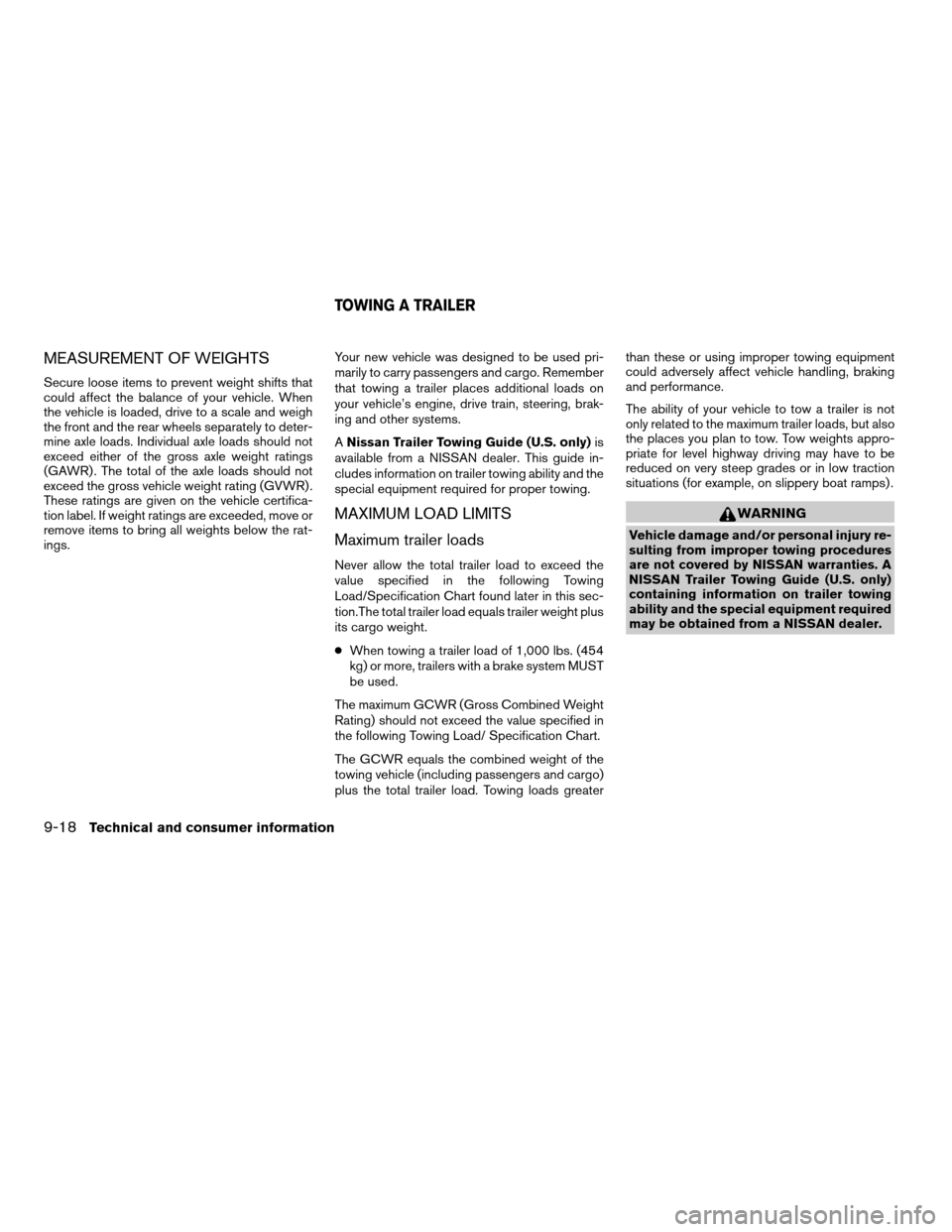
MEASUREMENT OF WEIGHTS
Secure loose items to prevent weight shifts that
could affect the balance of your vehicle. When
the vehicle is loaded, drive to a scale and weigh
the front and the rear wheels separately to deter-
mine axle loads. Individual axle loads should not
exceed either of the gross axle weight ratings
(GAWR) . The total of the axle loads should not
exceed the gross vehicle weight rating (GVWR) .
These ratings are given on the vehicle certifica-
tion label. If weight ratings are exceeded, move or
remove items to bring all weights below the rat-
ings.Your new vehicle was designed to be used pri-
marily to carry passengers and cargo. Remember
that towing a trailer places additional loads on
your vehicle’s engine, drive train, steering, brak-
ing and other systems.
ANissan Trailer Towing Guide (U.S. only)is
available from a NISSAN dealer. This guide in-
cludes information on trailer towing ability and the
special equipment required for proper towing.
MAXIMUM LOAD LIMITS
Maximum trailer loads
Never allow the total trailer load to exceed the
value specified in the following Towing
Load/Specification Chart found later in this sec-
tion.The total trailer load equals trailer weight plus
its cargo weight.
cWhen towing a trailer load of 1,000 lbs. (454
kg) or more, trailers with a brake system MUST
be used.
The maximum GCWR (Gross Combined Weight
Rating) should not exceed the value specified in
the following Towing Load/ Specification Chart.
The GCWR equals the combined weight of the
towing vehicle (including passengers and cargo)
plus the total trailer load. Towing loads greaterthan these or using improper towing equipment
could adversely affect vehicle handling, braking
and performance.
The ability of your vehicle to tow a trailer is not
only related to the maximum trailer loads, but also
the places you plan to tow. Tow weights appro-
priate for level highway driving may have to be
reduced on very steep grades or in low traction
situations (for example, on slippery boat ramps) .
WARNING
Vehicle damage and/or personal injury re-
sulting from improper towing procedures
are not covered by NISSAN warranties. A
NISSAN Trailer Towing Guide (U.S. only)
containing information on trailer towing
ability and the special equipment required
may be obtained from a NISSAN dealer.
TOWING A TRAILER
9-18Technical and consumer information
ZREVIEW COPY:Ð2003 Truck/Frontier(d22)
Owners Manual(owners)ÐUSA English(nna)
01/15/03Ðarosenma
X
Page 252 of 272

Trailer towing tips
In order to gain skill and an understanding of the
vehicle’s behavior, you should practice turning,
stopping and backing up in an area which is free
from traffic. Steering stability and braking perfor-
mance will be somewhat different than under
normal driving conditions.
cAlways secure items in the trailer to prevent
load shift while driving.
cAvoid abrupt starts, acceleration or stops.
cAvoid sharp turns or lane changes.
cAlways drive your vehicle at a moderate speed.
cAlways block the wheels on both vehicle and
trailer when parking. Parking on a slope is not
recommended; however, if you must do so,
and if your vehicle is equipped with an auto-
matic transmission, first block the wheels and
apply the parking brake, and then move the
transmission shift selector lever into the P
(Park) position. If you move the shift selector
lever to the P (Park) position before blocking
the wheels and applying the parking brake,
transmission damage could occur.
cWhen going down a hill, shift into a lower gear
and use the engine braking effect. When go-
ing up a long grade, downshift the transmis-
sion to a lower gear and reduce speed toreduce chances of engine overloading and/or
overheating. However, for long steep grades,
do not stay in 1st or 2nd gear when driving
above 35 MPH (56 km/h) .
cIf the engine coolant rises to an extremely high
temperature when the air conditioner system
is on, turn off the air conditioner. Coolant heat
can be additionally vented by opening the win-
dows, switching the fan control to high and
setting the temperature control to the HOT
position.
cTrailer towing requires more fuel than normal
circumstances.
cAvoid towing a trailer for your vehicle’s first
500 miles (805 km) .
cHave your vehicle serviced more often than at
intervals specified in the recommended Main-
tenance Schedule in the “NISSAN Service
and Maintenance Guide”.
cWhen making a turn, your trailer wheels will be
closer to the inside of the turn than your vehicle
wheels. To compensate for this, make a larger
than normal turning radius during the turn.
cCrosswinds and rough roads will adversely
affect vehicle/trailer handling, possibly caus-
ing vehicle sway. When being passed by
larger vehicles, be prepared for possible
changes in crosswinds that could affect ve-hicle handling. If swaying does occur, firmly
grip the steering wheel, steer straight ahead,
and immediately (but gradually) reduce vehicle
speed. This combination will help stabilize the
vehicle. Never increase speed.
cBe careful when passing other vehicles. Pass-
ing while towing a trailer requires considerably
more distance than normal passing. Remem-
ber, the length of the trailer must also pass the
other vehicle before you can safely change
lanes.
cTo maintain engine braking efficiency and
electrical charging performance, do not use
5th gear (manual transmission) or overdrive
(automatic transmission) .
cAvoid holding the brake pedal down too long
or too frequently. This could cause the brakes
to overheat, resulting in reduced braking effi-
ciency.
When towing a trailer, transmission
oil/fluid should be changed more fre-
quently. For additional information, see the
“Maintenance and do-it-yourself” section
earlier in this manual.
9-22Technical and consumer information
ZREVIEW COPY:Ð2003 Truck/Frontier(d22)
Owners Manual(owners)ÐUSA English(nna)
01/15/03Ðarosenma
X
Page 259 of 272
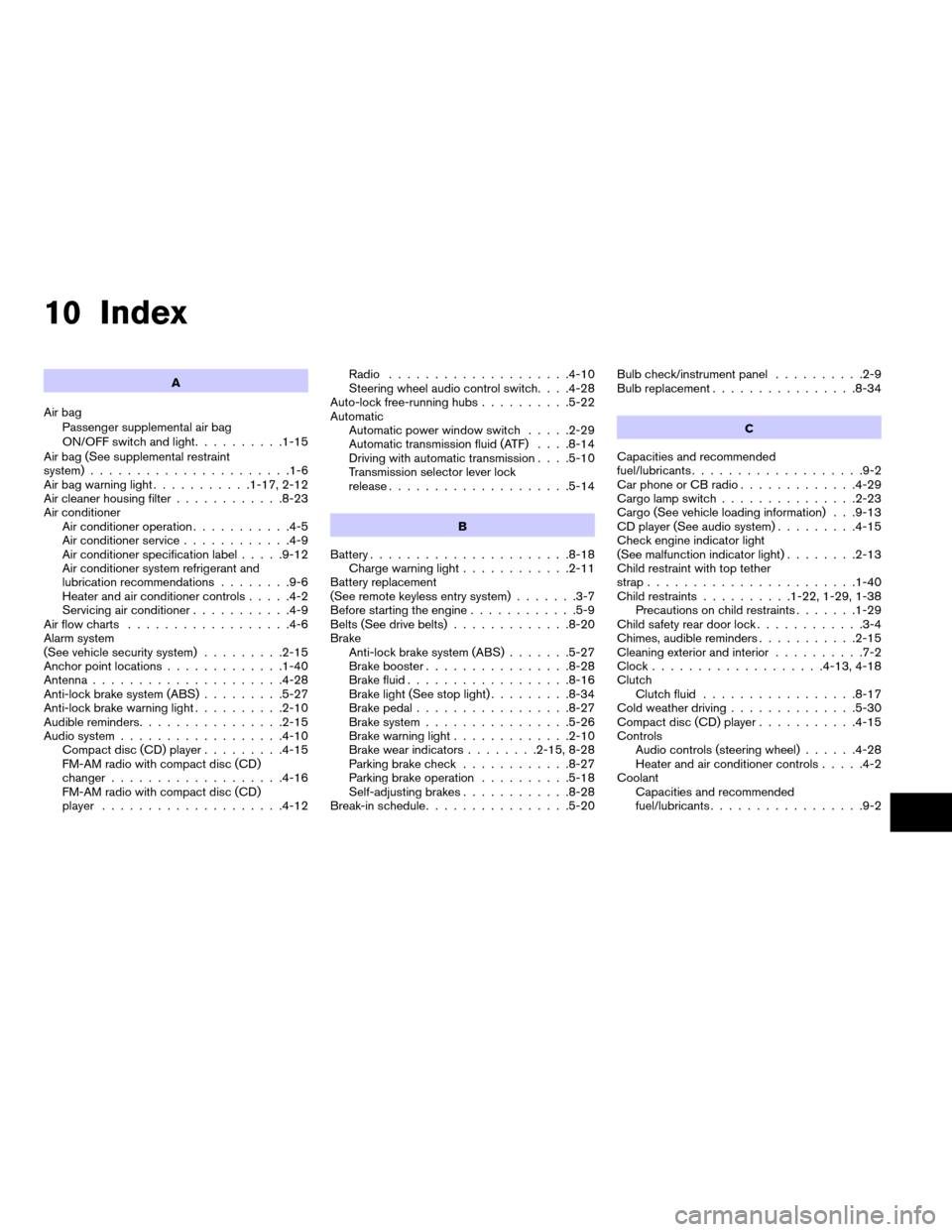
10 Index
A
Air bag
Passenger supplemental air bag
ON/OFF switch and light..........1-15
Air bag (See supplemental restraint
system)......................1-6
Air bag warning light...........1-17, 2-12
Air cleaner housing filter............8-23
Air conditioner
Air conditioner operation...........4-5
Air conditioner service............4-9
Air conditioner specification label.....9-12
Air conditioner system refrigerant and
lubrication recommendations........9-6
Heater and air conditioner controls.....4-2
Servicing air conditioner...........4-9
Air flow charts..................4-6
Alarm system
(See vehicle security system).........2-15
Anchor point locations.............1-40
Antenna.....................4-28
Anti-lock brake system (ABS).........5-27
Anti-lock brake warning light..........2-10
Audible reminders................2-15
Audio system..................4-10
Compact disc (CD) player.........4-15
FM-AM radio with compact disc (CD)
changer...................4-16
FM-AM radio with compact disc (CD)
player....................4-12Radio....................4-10
Steering wheel audio control switch. . . .4-28
Auto-lock free-running hubs..........5-22
Automatic
Automatic power window switch.....2-29
Automatic transmission fluid (ATF). . . .8-14
Driving with automatic transmission. . . .5-10
Transmission selector lever lock
release....................5-14
B
Battery......................8-18
Charge warning light............2-11
Battery replacement
(See remote keyless entry system).......3-7
Before starting the engine............5-9
Belts (See drive belts).............8-20
Brake
Anti-lock brake system (ABS).......5-27
Brake booster................8-28
Brake fluid..................8-16
Brake light (See stop light).........8-34
Brake pedal.................8-27
Brake system................5-26
Brake warning light.............2-10
Brake wear indicators........2-15, 8-28
Parking brake check............8-27
Parking brake operation..........5-18
Self-adjusting brakes............8-28
Break-in schedule................5-20Bulb check/instrument panel..........2-9
Bulb replacement................8-34
C
Capacities and recommended
fuel/lubricants...................9-2
Car phone or CB radio.............4-29
Cargo lamp switch...............2-23
Cargo (See vehicle loading information) . . .9-13
CD player (See audio system).........4-15
Check engine indicator light
(See malfunction indicator light)........2-13
Child restraint with top tether
strap.......................1-40
Child restraints..........1-22, 1-29, 1-38
Precautions on child restraints.......1-29
Child safety rear door lock............3-4
Chimes, audible reminders...........2-15
Cleaning exterior and interior..........7-2
Clock...................4-13, 4-18
Clutch
Clutch fluid.................8-17
Cold weather driving..............5-30
Compact disc (CD) player...........4-15
Controls
Audio controls (steering wheel)......4-28
Heater and air conditioner controls.....4-2
Coolant
Capacities and recommended
fuel/lubricants.................9-2
ZREVIEW COPY:Ð2003 Truck/Frontier(d22)
Owners Manual(owners)ÐUSA English(nna)
01/15/03Ðarosenma
X